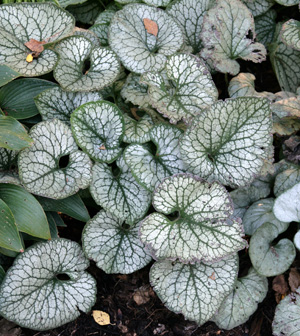
The Perennial Plant Association, a trade organization established to promote the use and sale of herbaceous perennials, has named Brunnera macrophylla ‘Jack Frost’ as the Perennial Plant of the Year 2012. This cultivar of the plant commonly called Siberian bugloss, False Forget-Me-Not, or Heartleaf Brunnera in the borage family (Boraginaceae) is hardy in zones 3 to 8. It is grown primarily for its shimmering foliage that brightens up any corner of the landscape but the small flowers are also attractive. The species in native to Eastern Europe, including Siberia, but this patented cultivar was a sport of Brunnera macrophylla ‘Langtrees’ (aka ‛Silver Spot’, with leaves dotted with silver) that was introduced by Walters Garden in Michigan in 2000.
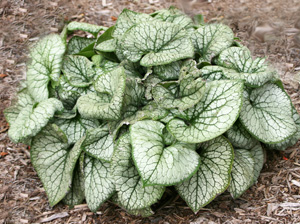
‘Jack Frost’ forms a rounded mound of foliage to 1½ feet tall and wide. Clumps spread very gradually by creeping rhizomes to eventually form a thick ground cover. The rough-textured and slightly hairy, heart-shaped leaves are a dark green overlaid with a distinctive frosted, silvery white color except on the veins and margin, creating a crackled pattern. They remain fresh-looking throughout the growing season, unless the plant does not receive enough moisture, when the leaves will develop dried-out brown spots.
In mid-spring, hundreds of tiny flowers bloom in airy sprays above the foliage for 3-4 weeks. The light blue flowers with yellow centers have five petals and resemble forget-me-nots.
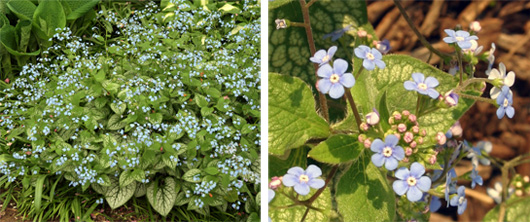
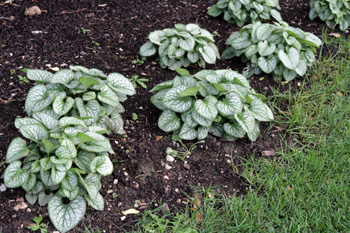
Use ‘Jack Frost’ in groups or individually in woodland gardens or formal beds to add dramatic texture to shady spots. It contrasts nicely with the fern Athyrium niponicum var. pictum ‘Silver Falls’ (or another cultivar of Japanese painted fern with silvery foliage) for a contrast in texture and leaf shape. This plant also combines well with astilbes, bleeding heart and Heucheras and is at home around ponds or streams. Position clumps with daffodils and other late spring bulbs that bloom at the same time as ‘Jack Frost’ for a lovely spring show. It could be used as a ground cover or to edge shady paths or borders.

Plant ‘Jack Frost’ in part shade (preferably morning sun and afternoon shade) in moist soil with good drainage. Although it prefers soils rich in organic matter, it does well in clay as well. It tolerates more sun than many other variegated cultivars of this species. ‘Jack Frost’ has few pests and is not bothered by rabbits or deer. This is a very low-maintenance perennial, requiring little care other than supplemental water during dry conditions. Mulch to maintain soil moisture and watering may not be required. This cultivar is more heat tolerant than many other Brunnera varieties. The plant’s appearance is improved by cutting off the spent flower stalks, but that is not necessary.
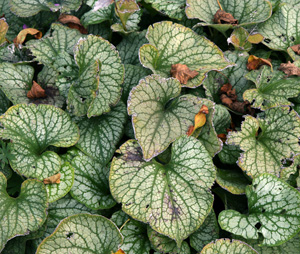
Individual older, tattered leaves can be cut back during the growing season to improve the clump’s appearance if desired. The old foliage should be removed in spring when the new leaves begin to emerge rather than in the fall as the leaves help protect the plant over the winter. Winter mulch is recommended, but often not necessary.
Because ‘Jack Frost’ is patented, unlicensed propagation for sale is prohibited. The fibrous-rooted plants can be divided in spring or fall. This cultivar will not grow true from seed.
– Susan Mahr, University of Wisconsin – Madison
Ask Your Gardening Question
If you’re unable to find the information you need, please submit your gardening question here:





 Aster, Symphyotrichum spp.
Aster, Symphyotrichum spp. Fascinating Fasciation
Fascinating Fasciation Alternatives to Lawn: Groundcovers
Alternatives to Lawn: Groundcovers Marigolds
Marigolds


